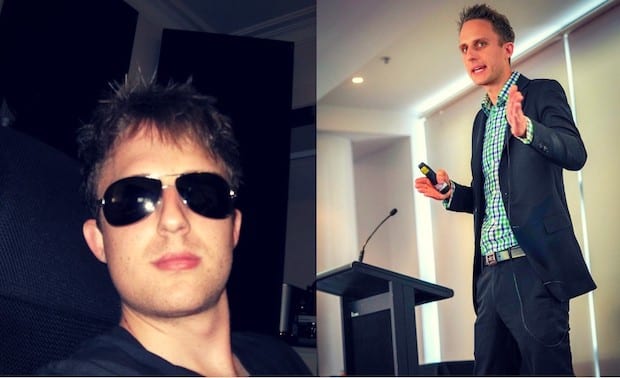Success Advice
7 Ways Joe Cross Started A Global Movement And So Can You

One of the things that motivates me is speaking with people like Joe Cross, who I recently interviewed. He is most known for making the documentary series Fat, Sick & Nearly Dead, which has now been seen on CNN, Netflix, Channel 9 Australia, and on UK Television BY MORE THAN 20 MILLION PEOPLE!
The global movement that Joe has created now see’s his website (rebootwithjoe.com) getting over 600K of unique views per month, 700K of Facebook followers, 150K of Twitter followers and 50K of Instagram followers. This interview taught me so much about success, and Joe is a real down to earth, genuine guy but also an amazing serial entrepreneur at the same time who has had some hits and some misses.
Before he got into the juicing, in 2008 he sold his very successful company BrokerOne, which was the largest futures brokerage firm in Australia at the time. Not only has Joe built his own businesses but he has also helped other entrepreneurs in the fashion industry like Kit Willow and Thakoon Panichgul (made famous my Michelle Obama) with creating success and wealth.
The highlight of Joe’s career has been creating a global movement through his documentary “Fat, Sick & Nearly Dead,” and I am now going to share with you the seven ways that Joe started his global movement and how you can do the same.
1. You must portray yourself in the right way
To build a global movement, you must be true, honest and transparent to your audience. You can’t think about your movement as a crowd you have to think about them as individuals.
When Joe makes a movie or writes a book, he thinks about the person sitting in their living room in Indiana watching his documentary or the person in London sitting in a park reading his blog.
“Crowds are dumb, but people are really smart”
People are pretty good at telling when something is not real, and we have all seen the backlash that can happen if you are not genuine.
To be able to attract people to your audience, you need to be consistent with your messaging and admit when you are wrong. This comes back to the age-old philosophy of learning from your mistakes and not letting them happen again.
2. Tell great compelling stories
Joe believes that the world is quite binary. You’re either awake or asleep, dead or alive, male or female, healthy or unhealthy, broken or not broken. Only you know if you are broken and some people drift in and out of being broken, some people are never broken while others are just broken all the time.
When it comes to story telling Joe has the same binary view that you can either tell a story or you can’t. You either have the gift, or you don’t. Running fast is a good example; some people can run fast while others like Joe are slow and no matter how hard he trains, he will never be fast.
The same goes for telling a story, if you’re good at it you have to work on it, and you have to be aware. When you’re telling your story to an audience, you have to be fully conscious and aware.
You need to be able to pick up every bit of sensory information from the audience as to whether you’re telling your story too fast or too slow, whether it’s funny enough or not and whether you are waffling too much. These things all come naturally to a good storyteller and if you’re not one of these then keep your stories short. Don’t try and be long winded because it won’t work, and you will turn people off.
“Know if you’re a square peg and go into a square hole, don’t be a square peg trying to go into a round hole”
3. Work out the best medium for your movement
Joe doesn’t believe that there is necessarily a best medium to build a global movement; he says it’s more about what your message or story is as to which medium will work best. For Joe, he found that documentaries were the best way to show the journey he had been on, and he honestly believes that documentary making chose him.
Joe describes the medium of documentaries as documenting reality, which was exactly what he was doing with his story. At the time Joe was making his documentary, the amount of people that knew him and the subject of juicing was not enough to do a television series, so a one-off documentary made the most sense.
One challenge of making a documentary is that you need the money although Joe says that it’s better not to have too much money. The more money you have to make the documentary, the more mistakes you make. Sometimes having no idea what you’re doing (Joe had no experience) can be both a benefit and a hindrance.
The lack of experience was a benefit for Joe because the subject of juicing hadn’t really been done before. On the other hand, the lack of experience could have been seen as a hindrance. One mistake that Joe admits to making was editing the first documentary very early on before the filming was complete.
This led to an increase in costs because the editing team / postproduction team began editing things and then the direction of the documentary would change, and the parts they edited were no longer needed. The other mistake he made was hiring too many people for each part of the film.
On his later films, Joe learned to finish all the filming first before trying to edit anything. The lack of experience on the first documentary was also very helpful because Joe trusted his gut instinct and decided to go and follow one of the character’s stories for a large part of the film.
When he made this decision, the filming had already been completed and so they had to come together again to start filming. The monetary costs of that decision were quite high, but Joe’s lack of experience paid off because the audience loved the outcome.
In the first few years of the documentary process, there was no income, the income only started in 2011 when the movie launched officially and revenue started coming in from Netflix. The risk of choosing documentary making to build your global movement is that once it’s ready to pitch, Netflix (the monopoly player in the space) could say no to showing your film.
Even if they say yes, there is a chance that people don’t watch it which could result in you not being able to recoup the production costs. Still, if the story or message is good, documentary making is a great risk to take, especially as the cost of filming equipment has fallen since Joe’s movie was made.
4. Monetise to keep building the movement
Knowing why you want to build a global movement is really important. In Joe’s case, he didn’t start his website RebootWithJoe.com for money but what he eventually realized is that to keep it going he needs to generate money from it.
There is nothing wrong with trying to monetise your global movement as long as you are open and transparent about the way in which you go about it. Monetising an audience is relatively new to the average entrepreneur or startup but for the old giants in radio and television, it’s been around for years.
If you have some advertising on your site, people don’t pay for that, so it allows them to get some value for free as well as providing you an income at the same time. Most things are free on Joe’s website; it is only when someone wants a juicer then they might click a link on the site that takes you to Amazon and then Joe gets an affiliate fee.
When people know they are getting something like a book, an app, a personal consultation or a coaching session, they are usually happy to pay for that. It’s all about your value proposition and being very clear about what you’re offering.
You want the audience to say to themselves “I’m getting a lot for free on this site like inspiration and education, if I want to go to the next level then I need to pay for that.”
This concept is not something that is difficult for people to understand.
5. Leverage social and listen to Joe’s tips
To get on Netflix you have to have made good content in the first place, there’s no real magic secret to that. Once you go viral on Netflix, and you are going into millions of people’s homes, it’s not difficult to see your social media following explode.
There are Instagramers that have millions of followers because they’re good looking and wear tight pants, but you can’t measure that audience to one that is a business and generates income like Joe’s. The reason for this is because the followers of those Instagramers are often very young and don’t spend any money.
Try not to get too caught up in the numbers of followers too much but focus on the transaction level of each member. Focus on whether you are offering services and products that your audience are finding beneficial and willing to pay for. If they are beneficial, then they will tell their family and friends and you will have a sustainable business.
To use social media effectively you need to be focused, true to the story you want to tell, transparent, and not take sides in an argument or get too political. Another one of Joe’s tips is to stay clear of alienating people and be as inclusive as you can with everyone.
There are times when Joe could post an incredible photo of himself doing something amazing in the world that very few people could ever get to do, but he’s reluctant to post photos like that. The reason behind this is because there is no benefit of showing a photo of yourself in a private jet somewhere.
If you think of each audience member individually and picture them sitting on their couch at home looking at your photo, ask yourself, would they be able to get inspired or learn something from your photo? Some people use social media to say to people “look at the great life I have.”
Instead, use social media to show inspiration and if you see a beautiful beach somewhere then post that because that’s nature, and that’s motivating. Be careful about being too material. There are times when it’s appropriate but most of the time you should shy away from it if you’re trying to build a global movement.
“Most people would love to have their life be as good as their Instagram page – be real”
If you’re following someone on Instagram that makes you feel less of a person or insecure then unfollow them. Keep building your movement and don’t bring those types of people into your world, as they will distract you from your vision.
I asked Joe why he has so many raving fans and ambassadors, and he said to me “it’s simple Tim, they have drunk the cool aid (juice) literally.”
“When people make huge changes to their life, and they’re not Fat, Sick & Nearly Dead anymore, and they’re not broken and have their life back, they become your ambassadors automatically without you having to do anything.“
Joe doesn’t take any credit for people’s transformations and sees them as having made the changes themselves – he is just the catalyst and inspiration. While building your global movement, have a think about how you can have a similar reaction and change people’s lives in some way.
If you get this right, then you will have the same power that Joe’s movement has had and the raving fans will be attracted to your audience.
6. Partner with someone who’s part of the story
Partnerships don’t work when either party is benefiting a lot more than the other. In the case of partnering with a juicer company like Breville, Joe chose them because they were part of his story and were used in the movie, so it kept the story real.
He also liked them because he’s Australian, and they are an Australian company. To sum up, the partnership simply aligns with Joe’s beliefs and message – simple.
“Partnerships work when both sides have a good deal”
Getting the attention of a potential partner is quite straightforward these days. If there is a partner that aligns with your movement and you want to get them on board, do what Joe did, start to post photos of their product or service on your social media.
For Joe, the process of doing this led to Breville asking him to come and show a pre-screen of his documentary to their staff, and then when they were able to see an increase in sales for a few months after the movie was released, the partnership became an obvious next step.
“The key is to be able to prove to the partner a little bit of benefit or traction first, before making any formal proposal”
Woolworths were also involved with Joe’s movement, and they sold his Reboot Your Life juice in their produce section of all their supermarkets. Joe took a different approach with them and made contact with a board member of the company, who then introduced him to the Head Of Produce at Woolworths.
The obvious link for Woolworths with what Joe was doing was that he was encouraging people to change their life through juicing, which resulted in an increase of produce sales. (Note that Reboot Your Life juices are no longer available.)
7. Expand your movement through public speaking
A great way to build your global movement is to do some public speaking. Public speaking can have a major impact on delivering your message, but it’s also the thing that people fear most. Try and implement the below points that Joe recommends and you should be fine.
– Remember that people have come to see you speak and they have given up time in their life. They could be doing other things so because of this; they will usually be respectful of you from the start.
– It’s very easy to become nervous or insecure if you’re talking about a topic that you don’t know much about or are not passionate about. When you know your subject well, you can speak from a position of authority. People are not coming to hear about something you don’t know about; they are coming to hear about how to change their life for the better and get more out of life.
– To start out, it’s best to talk with no microphone because this can sometimes be off putting if it’s your first time speaking public. When you speak in front of larger crowds, and you get a reverberation back from needing to use a microphone, you just have to mentally try and get over that, and it can take time. When you’re talking to a few thousand people you will still get nervous and that’s okay, most people are the same.
– Speaking without notes can pose a challenge if you lose your train of thought. One tip that Joe learned when this happens is to be honest with the crowd and tell them you have lost your train of thought. Say something like “I have actually forgotten the next thing I was going to say,” this will give you time to recover rather than trying to think in silence in front of an audience.
– Before the stepping out onto the stage try taking deeps breaths, drinking heaps of water (stay near a toilet), having a peak at the audience through the curtain, and thinking to yourself that it’s all good, this will help keep your nerves under control.
***Final Thought From Joe***
Perception is a big thing and leading a movement is about steadying the nerves and competence. There are four things that Steve Job’s says you need to be successful, and Joe says they are the same four things you need to build a global movement:
- You need to be able to take risks and put your money where your mouth is
- You have to be really passionate about what you’re doing
- You have to be able to make huge sacrifices
- You need a lot of luck (you can’t control this one)
Joe is currently filming his brand new documentary “Little Humans” which will be available next year, but in the meantime, check out his website RebootWithJoe.com to find out more about his story and how you can change your life.
Change Your Mindset
The Silent Skill That Makes People Respect You Instantly
What truly earns respect and why most people go about it the wrong way

Everybody craves respect but not everyone earns it. Some people believe that a title, years of experience, or a position of authority automatically entitles them to respect. (more…)
Entrepreneurs
The Essential Skills Every Entrepreneur Needs In 2026
Success in the digital age isn’t about luck. It’s about mastering the skills that separate dreamers from doers.

When I was 22 years old, I started my first side hustle as a ghostwriter. (more…)
Did You Know
The Success Patterns You Inherited (And Didn’t Notice)
Your family history may hold the key to why you think, act, and feel the way you do today.

Who are you? Your experiences and your family’s narratives and legacies contribute to your identity. Your ancestry contains individual traits and forces that have been inherited over the years. It also carries the fights and victories of your forebears and older family members. (more…)
Shift Your Mindset
11 E’s That Define Every Great Leader And Why Most People Miss Them
If you’ve ever felt the pull to lead, this is your roadmap to turning inner potential into lasting influence.

What Is Leadership, Really?
Leadership is far more than a title or position. It’s the ability to envision a future, inspire others, and align people toward a shared goal. (more…)
-

 Change Your Mindset4 weeks ago
Change Your Mindset4 weeks agoThe One Leadership Habit That Separates the Great From the Forgettable
-

 Personal Development3 weeks ago
Personal Development3 weeks agoThis Silent Habit Might Be Sabotaging Your Career
-

 Business3 weeks ago
Business3 weeks agoWhy Your E-Commerce Fulfilment Is Probably Broken (And How to Fix It)
-

 Shift Your Mindset2 weeks ago
Shift Your Mindset2 weeks ago11 E’s That Define Every Great Leader And Why Most People Miss Them
-

 Did You Know2 weeks ago
Did You Know2 weeks agoThe Success Patterns You Inherited (And Didn’t Notice)
-

 Business2 weeks ago
Business2 weeks agoThe Hidden Money Pit in Your Operations (and How to Use It)
-

 Entrepreneurs1 week ago
Entrepreneurs1 week agoThe Essential Skills Every Entrepreneur Needs In 2026
-

 Change Your Mindset6 days ago
Change Your Mindset6 days agoHow to Turn Your Mind Into Your Greatest Asset (Instead of Your Enemy)




















